PART 4: Perth Auxiliary Bishop Don Sproxton recalls Tantur journey
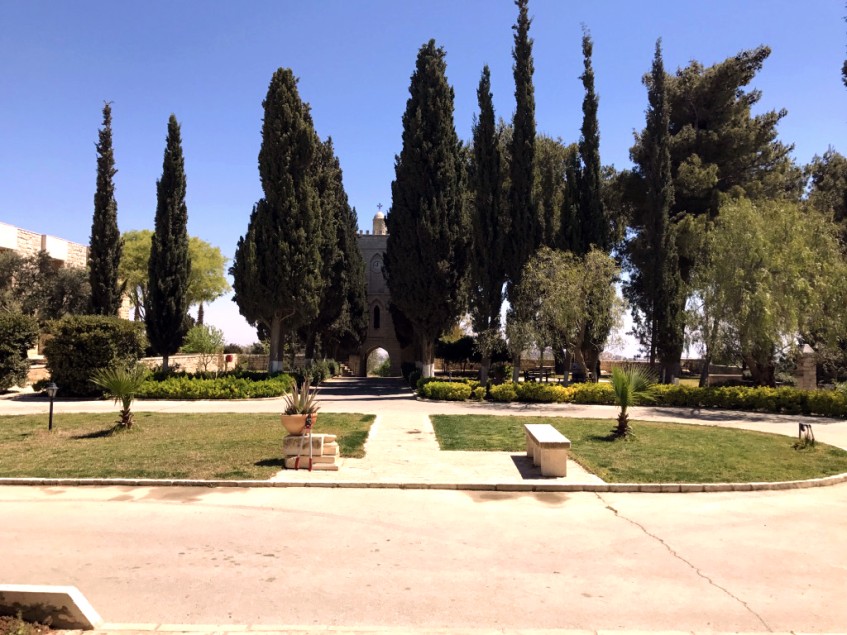
Tantur Ecumenical Institute. Photo: Gemma Thomson.
Perth Auxiliary Bishop Don Sproxton last month spent some three weeks in Israel visiting the Tantur Ecumenical Institute. wrote to The eRecord during the Easter period to speak about his experience.
In this fourth part of Bishop Sproxton’s experience, he describes his journey during the Easter period.
With our return to Jerusalem, we realised that our time in the Holy Land would shortly be coming to an end. Tantur had become more to us than a base. Once we were back in the familiar surroundings of the Institute, quite a number of us remarked that it was like being at home.
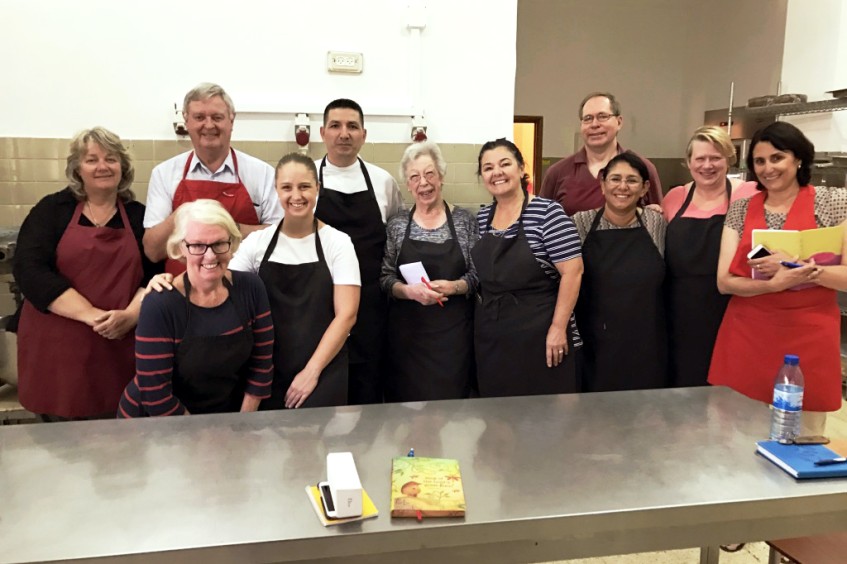
Perth pilgrims partaking in a Middle Eastern Cooking Class with Tantur Chef, Issa. Photo: Gemma Thomson.
Easter Saturday was to be a day of rest after the journey from Galilee. The group was determined, though, not to waste any time, given that we had only a few days left. The chef at Tantur very graciously offered to teach us some of the recipes of the traditional Palestinian cuisine.
Some of our group took advantage of his offer and spent the morning working with him to prepare the luncheon dishes. Despite the odd cut or burn, the participants enjoyed the experience and there was a lot of note taking so that our friends back in Australia may be able to share in the tastes of the Holy Land.
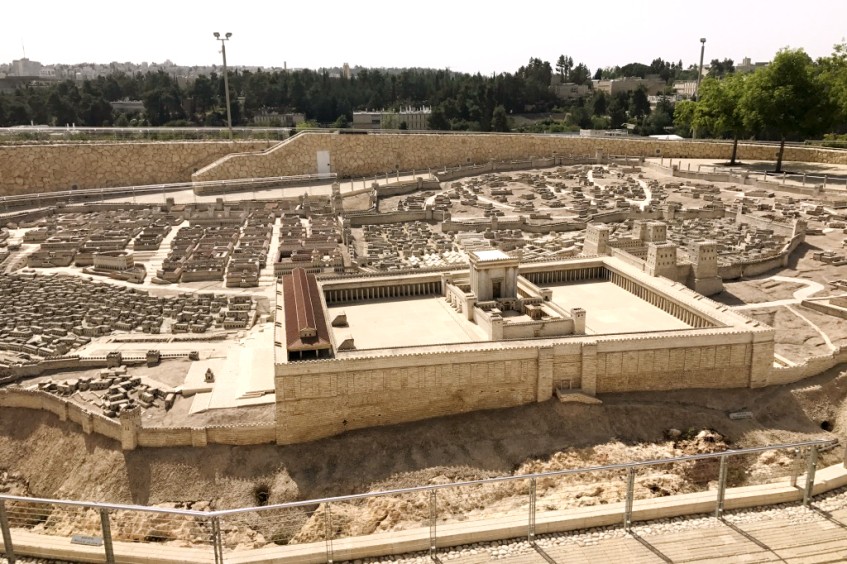
Amazing model of Jerusalem at the Israel Museum. Photo: Gemma Thomson.
In the afternoon, some of us went to the Israeli Museum. This institution is remarkable. The major interest for the student of the scriptures is the exhibition devoted to the Dead Sea Scrolls. In the upper level of the domed building where the scrolls are kept, you find the facsimile of the scroll of Isaiah.
The original was discovered in one of the caves at Qumran, overlooking the Dead Sea, fairly close to Jericho. The scroll is entirely preserved having been placed in a clay jar and hidden in the cave nearly 2000 years ago. It is in remarkably good condition. Hundreds of other segments of scrolls have been discovered in the caves above the Qumran community ruins.
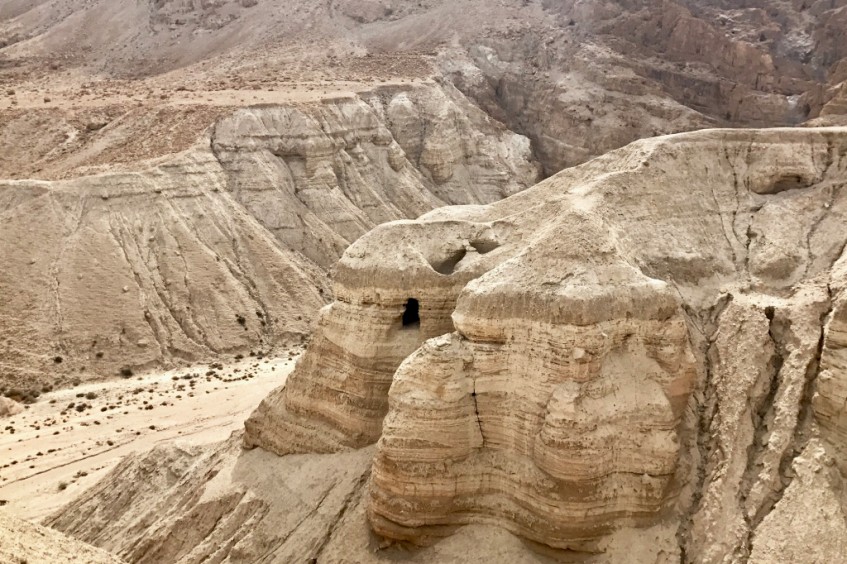
The caves at Qumran where the Dead Sea Scrolls were discovered. Photo: Gemma Thomson.
The many exhibitions include a magnificent archaeological collection that spans the periods from when humans first inhabited the region of Canaan to the Roman and Byzantine times. There is a wonderful collection of Jewish textiles and ceremonial costumes, and recreations of the interiors of synagogues that have been donated to the museum by many countries.
In the evening, we heard a very interesting lecture on the current political and religious issues of Islam today.
Our last Sunday saw us travel to Tel Aviv to celebrate Mass with Fr David Neuhaus SJ at the pastoral centre for migrant workers and asylum seekers. Our Lady Woman of Valor Centre and Ministry serves a majority of Philipino workers who work in difficult conditions in the modern city. We received a very warm welcome from the people who enthusiastically celebrated the Mass. Tel Aviv is very liberal and has challenged the Sabbath regulations so that more businesses trade every day of the week. It has become a sprawling city that has absorbed smaller cities such as Jaffa.
We travelled a short distance to the ancient coastal town of Jaffa, known in biblical times as Joppa. After lunch we roamed the old quarter, finishing our visit at the church of St Peter. The art in the church celebrates the dream of Peter that is recorded in the Acts of the Apostles.
St Peter saw a vision of many animals and was invited by the Lord to take any of them for food. Some of these were forbidden to be consumed in the dietary laws of the Jewish people. The vision helped St Peter realise that what he and the Jews had been offered through the redemption by Jesus was also to be offered to the Gentiles. This made the mission to the Gentiles much easier with the dietary laws and other restrictions being lifted. The words of Jesus that St Peter would have heard as they travelled together in Galilee must also have resonated in him, that what goes into a person does not make one unclean but what comes out of the person's heart can be impure.
Very near the church is the house where St Peter raised the disciple of Jesus, Tabitha, to life. A Christian family owns the house that now stands on the site of the house where the miracle was performed.
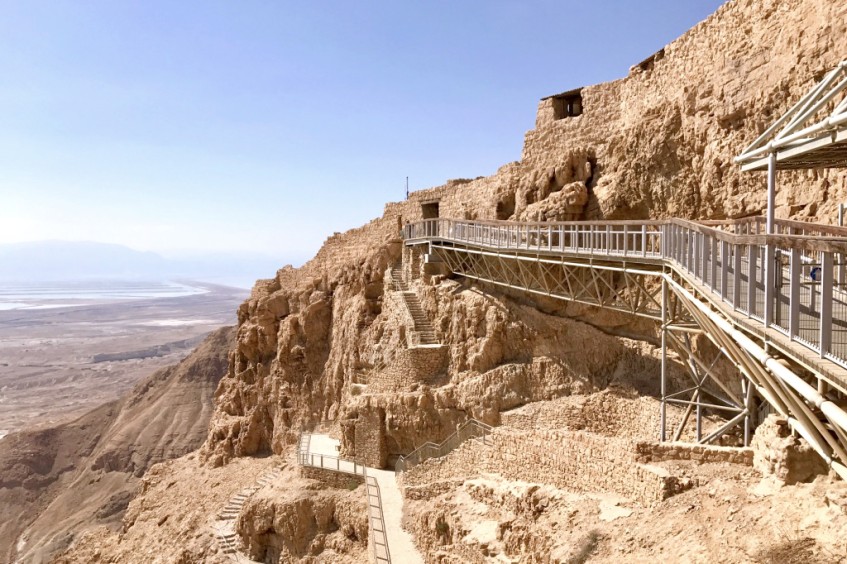
Panorama from Masada. Photo: Gemma Thomson.
The next day we were taken into the Judean desert. This arid country begins on the eastern outskirts of Jerusalem. The road we took leads to Jericho. It descends to a depth of about 300 feet below sea level. The valley contains the Dead Sea and it has cut through an ancient mountain range which was split by huge seismic forces caused by the tectonic plates of Asia and Africa tearing apart. We made our way to Masada.
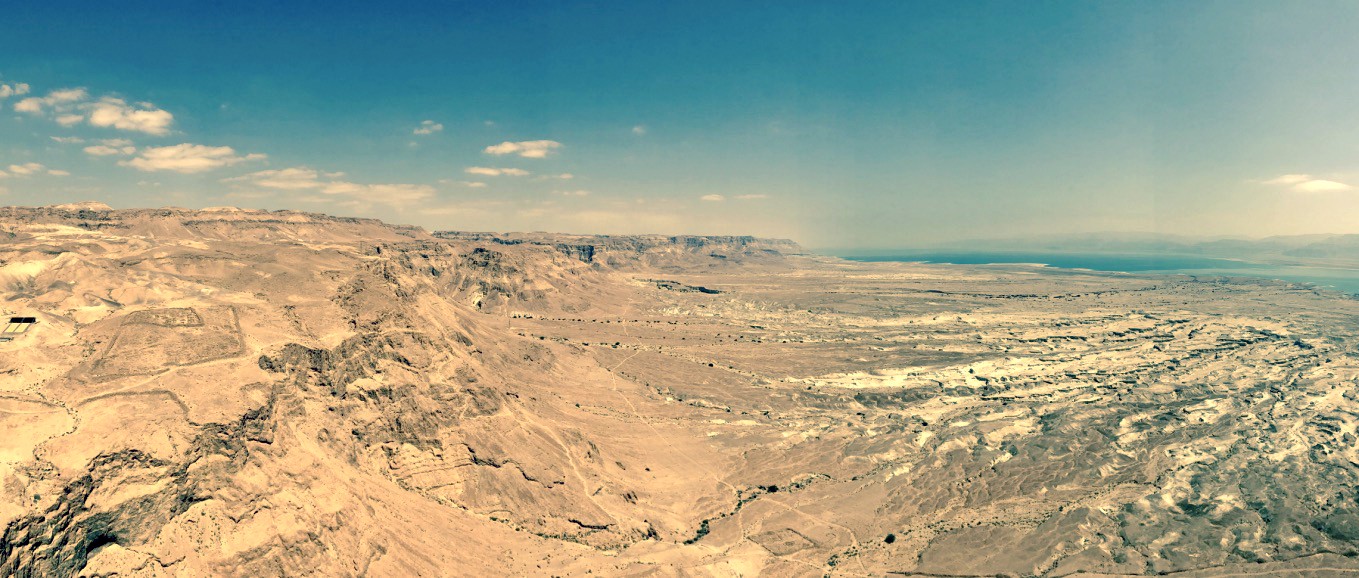
Panorama of Judean Desert from Masada. Photo: Gemma Thomson.
Masada is famous in Jewish history for it was the fortress that Herod built. It was a safe place for the King, his family and nobles to retreat to in times of emergency. Herod had built an amazing palace, enormous storerooms and garrison on the top of the flat topped mountain with plunging cliffs to the valley floor. It became the place in the revolt by the Jews against the Romans about 70 AD were a stand was taken by the rebels and their families. The Romans laid siege against the fortress and managed to build an earthwork to bring a gigantic siege machine to a defensive wall through which they were able to break into the fortress. To the Romans' surprise, the people had realised the futility of their situation and decided to kill their families and themselves. They found all of the Jews in the fortress dead.
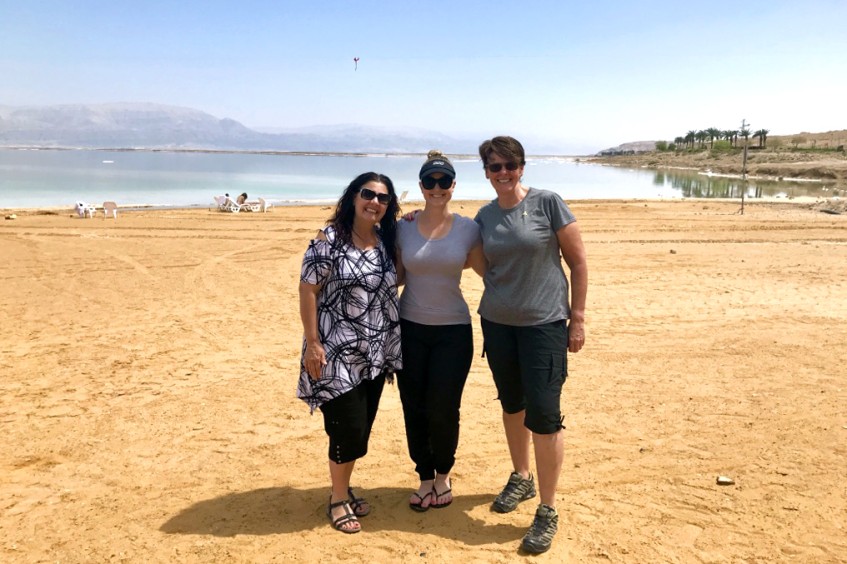
Perth Pilgrims at the Dead Sea. Photo: Gemma Thomson.
From Masada, we travelled further south to a popular resort on the Dead Sea and had lunch, before some of us went into the water to experience the unique sense of buoyancy. The water is 30 per cent salt, many times saltier that normal sea water. It is with some difficulty that you force your legs down after floating on your back in order to stand once more in the water.
Turning north we retraced our way to Qumran. The ruins of the settlement are in the shadow of steep hills. The caves in the hills are clearly seen, the same caves where the famous scrolls were found. There is debate about who built the settlement and what its purpose was. Was it a Jewish religious community that was responsible for writing and copying the scrolls? Was it a place for people to come to benefit from the healthy mineral mud and water of the Sea? Was it a factory producing pottery for traders who passed by on their way to the east? At least we can say that the place gave its name to the remarkable find of scrolls.
The first scrolls were discovered by a shepherd who threw a stone at a straying sheep. The stone missed the sheep and clattered into a cave. The stone struck something that made an unusual sound and it drew the boy to investigate. The first clay amphora was found. Scrolls of many of the scriptures and secular writings have since been found in the caves. They have been so helpful to biblical scholars in their research of the Old Testament.
Tuesday was a day of study. We had a lecture in the morning by Fr Neuhaus on Land History and the Bible. He gave an interesting presentation on the way the Jews see the land today and the interpretation of the texts concerning the promise of land given to Abraham, and how these ideas differ.
In the afternoon, a Jewish scholar gave us a study of the first two chapters of Genesis.
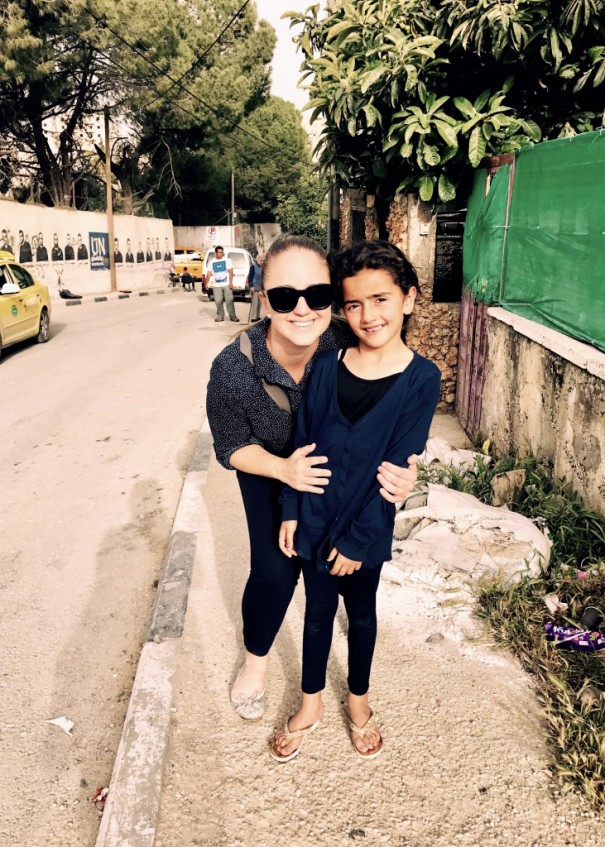
Perth pilgrim, Gemma Thomson, with a local refugee at Aida Refugee Camp in Bethlehem. Photo: Gemma Thomson.
Some of the group took an excursion with two guides, one Jewish and the other a Christian Palestinian. It was described as a dual narrative political tour. It involved going to Hebron to see the effect of the Jewish settlements on the Palestinian people. The group visited a building used as a synagogue and a mosque. Lunch was served at a kibbutz where a rabbi told of his work at promoting dialogue between Israeli and Palestinian people.
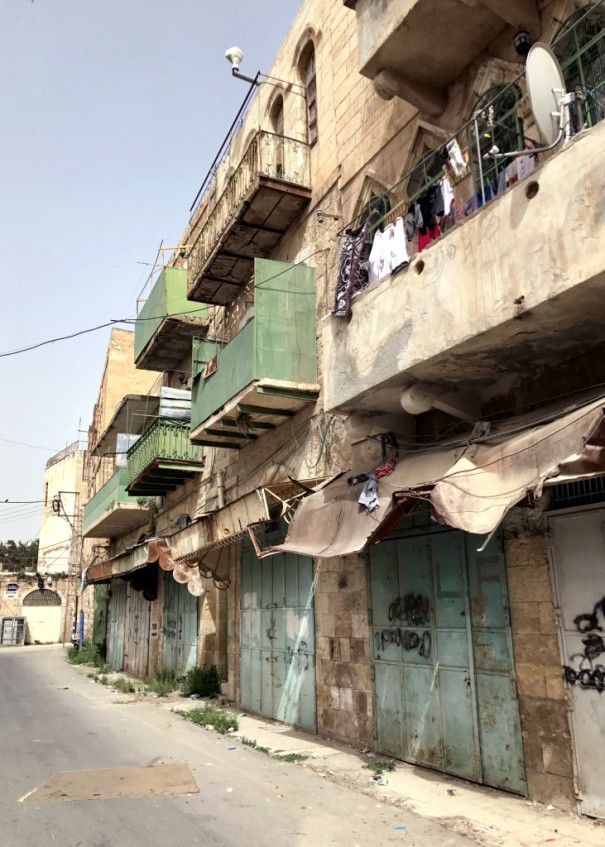
The streets of Hebron. Photo: Gemma Thomson.
The highlight of the day was to visit the Aida Refugee Camp in Beit Jala. It was amazing for the group to see the happiness and delight of the children. The refugees have been in this camp from the time in 1948 when their villages were destroyed. New generations of families are living there where they feel safe. The Lajeere Centre is connected to Aida Camp and provides educational programs for refugee children and their families.
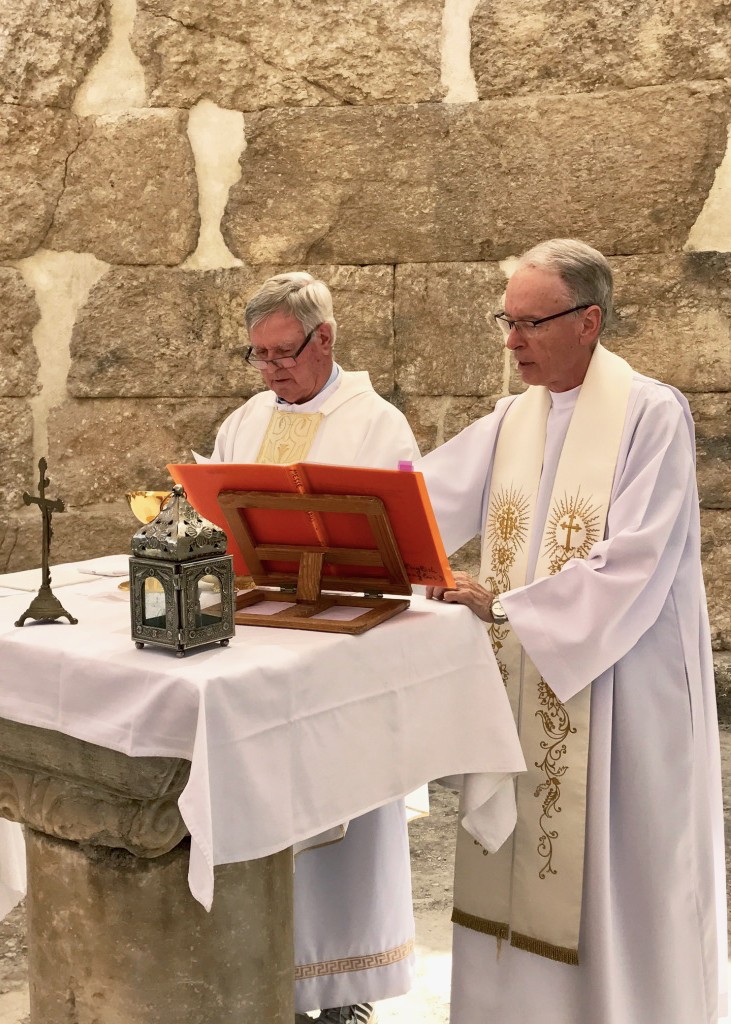
Emmaus Mass with Auxiliary Bishop Don Sproxton and Emeritus Bishop Brian Finnigan of Brisbane. Photo: Gemma Thomson.
And so we arrived at our final day. We set out for Emmaus. There we found the roofless crusader church built next to the ruins of a Byzantine church. We celebrated Mass with the gospel account of the two disciples who were walking away from Jerusalem but were joined by the Risen Lord. A beautiful icon is there of the disciples seated at the table at the moment they recognise Jesus as he breaks the bread. It was such a special moment for us too. We were to begin our journey back to Australia having walked along the roads that Jesus walked. We feel so privileged to have walked with Him this Easter in Jerusalem.
